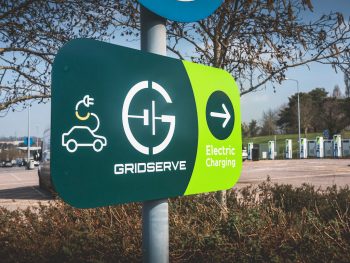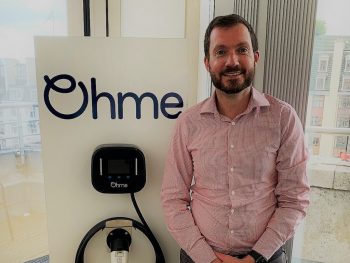World EV Day 2022: Expert views on what’s needed for charging
World EV Day 2022 is now underway, once again promoting sustainable mobility. We ask the fleet and automotive sector for their thoughts on how increased adoption is changing charging needs and where work is needed.

UK battery electric vehicle (BEV) uptake continues to grow and was up 35.4% year on year in August
It may have taken some years, but the UK electric vehicle sector has at last hit the big time.
Latest figures from the Society of Motor Manufacturers and Traders (SMMT) show that UK new car registrations were up by 1.2% in August, ending five months of decline and driven primarily by battery electric vehicles (BEVs). These recorded a 35.4% year-on-year increase in volumes and a 3.6% increase in market share to 14.5%.
Take-up has been boosted by ever-widening vehicle choices, fast-expanding electric ranges and attractive company car tax rates, while rising fuel prices and growing eco awareness have also had a big role.
The ramp-up of charging infrastructure has helped too and the public charging network continues to fast accelerate, as shown by latest Zap-Map stats. Reliability, while still far from perfect, is also on the up too.
The Government has set the goal of increasing the number of public electric car chargers more than 10 times to 300,000 by the end of 2030. To support that, it’s recently announced
new Local EV Infrastructure (LEVI) funding that will enable local authorities to install more than 1,000 charge points, furthering the work of the On-Street Residential Chargepoint Scheme (ORCS).
It also introduced its Rapid Charging Fund in the 2020 Budget, intended to ensure the rapid-charging network is ready for the 2030 ICE ban and with various ambitions for motorway charging provision.
And the Government said in last week’s mini-budget that it will further drive the LEVI scheme and Rapid Charging Fund as part of plans to accelerate infrastructure projects.
But despite all this, there are still issues. So where is the charging sector providing solutions and where is further work needed?

Gridserve has replaced all legacy motorway chargers on its Electric Highway
An evolving motorway network of fast chargers
Establishing a comprehensive network of fast chargers across the UK’s motorways has been especially important in tackling range anxiety and driving EV adoption. The vast majority of service areas have installed charge points and the Government has suggested it could mandate that service area operators and large fuel retailers must meet minimum charge point numbers at specific sites and increase levels over a period of time.
Gridserve, which acquired the Electric Highway from green energy firm Ecotricity in June 2021, has already overhauled its network. It’s upgraded over 160 EV charging locations with new chargers and already delivered eight additional High Power Electric Super Hubs – each with a bank of 6-12x 350kW-capable chargers. It’s also rolling out its Electric Forecourts and has also today started construction of a new site at Gatwick Airport.

Joe Ellwood, product specialist, ABB E-Mobility
Joe Ellwood, product specialist, ABB E-Mobility, says the UK’s network of fast chargers can help high-mileage drivers get from A to B quickly to meet customers, deliver goods and services or for personal reasons.
“All types of high-mileage drivers can benefit from the fastest charger on the market – and we’re now seeing the first installations in the UK. ABB’s Terra 360 is capable of fully charging an electric car in under 15 minutes.”
He continues: “Chargers are getting more powerful, more user-friendly, and quieter. Modern high-power chargers, like those at motorway service stations, are now capable of ‘power sharing’. As an example, a single cabinet could charge one vehicle at 350kW or two at up to 175kW. Another benefit of modern EV chargers is their smart software. This enables remote monitoring so that the operator can diagnose and resolve a large majority of issues from their control centre, minimising the cost of maintenance.”
But a challenge for those without off-street parking
Despite the ongoing investment, the distribution of charge points across the country remains patchy and there are obvious gaps, including for rural areas and councils that have not made the most of the Government’s ORCS scheme.

David Bushnell, director of consultancy and strategy at Fleet Operations
David Bushnell, director of consultancy and strategy at Fleet Operations, explains: “Outside of the motorway corridors, there is an obvious lack of supply, particularly in rural areas, and many charge points are not adequately maintained by councils that perhaps did not perform due diligence on charge point quality during the initial rush to install.
“This is not a problem for those who have an at-home charge point, but for employees in rented accommodation, a lack of dedicated parking space will drive them to use more expensive public charge points.
“For the vast majority of vans which go home with the driver rather than returning to a depot, space again presents the biggest challenge. Parking an eLCV on a drive to charge overnight may demote a private car to unpopular kerbside parking, while public charge point bays are often not large enough for a long wheelbase van.
“An 80% cap [on electric range] at public charge points would be a quick win for availability, while longer-term investment in more van-friendly charge points and further kerbside innovations, such as lamppost charging and pop-up hubs, should help to address charge anxiety.”
Furthermore, as the take-up of EV grows for fleets as well as car drivers, Trojan Energy says it’s important that EV charging is accessible and convenient, but this should not come at the expense of other road and pavement users.
CEO Ian Mackenzie goes on to say: “New charging technology being rolled out in the London boroughs of Barnet, Brent and Camden is designed to be flat-and-flush with the pavement, meaning it can be located where other, larger charge points cannot, enabling charging at the kerbside. Drivers carry with them charging lances that plug into the charge points. The result is on-street charging that leaves no permanent street clutter.
“A large-scale pilot project is set to launch in the South-East, aimed at on-street fleets for which charging has proved a barrier to electrification. Trojan Energy will install and operate a full service including maintenance for drivers who will be able to control their charging costs by utilising their own home electricity rate, including

Trojan Energy CEO Ian Mackenzie
eap overnight rates. This will operate on a subscription basis with no up-front capital cost. The focus of this technology is helping to broaden the options available to both fleets and private drivers who are not able to park off-street.”
Feasibility still an issue for vans
While availability and take-up of electric vans is lagging behind the car market, there have been some notable advances this year.
More than a third of all new van models are now available as either plug-in hybrid or full battery electric vehicles (BEVs) and latest figures from the Society of Motor Manufacturers and Traders (SMMT) show registrations of the latter soared in August.
But there’s still much work to be done to address the issues highlighted by Alphabet’s David Bushnell above. The SMMT has called for a national ‘van plan’ for charging to accelerate uptake after its research revealed 57% of van owners are anxious about going electric over fears they won’t be able to find a charging point when they need it. And the Association of Fleet Professionals (AFP) has published a national map revealing the locations where fleets need kerbside charging for company van drivers to go electric.
Herd Group, which provides a one-stop shop approach for van and fleet solutions, says that although there is a desire for many fleets to implement electric vans, the long and short is that feasibility is still an issue.

Scott Kennedy, business development manager and EV specialist, Herd Group
Scott Kennedy, business development manager and EV specialist, explains: “Factors prolonging adoption include charging infrastructure, product, education, availability, cost (initial outlay) and the diverse SME and Plc landscape, where it certainly isn’t ‘one size fits all’. Electric vans are an entirely different prospect for companies running LCVs to consider. They can have a multitude of usages and mileage requirements, with many different sectors to consider. Smaller vans certainly seem to have the majority of the market and can be run quite effectively with the battery size/payload/range ratio, very much offering a viable solution, however, as we look at larger vans, this ratio isn’t as efficient.
“This being the case, the key areas that we feel need government attention to encourage greater adoption would be:
- Simplicity and investment in both public and private charging infrastructure
- Investment in education across drivers and fleet managers in the SME sector
- Manufacturer investment in ‘real-world’ range figures for accurate sector decision making
- Financial support incentives for all fleet adoption methods (purchase/rental/leasing)
“By encouraging that the supplier network is all moving in the same direction to support e-LCV adoption in the fleet sector, utilising a consultative, simplified and joint approach, we will see fleets start to feel a lot more comfortable in committing to take on electric vans.”

Julian Skidmore, a senior software engineer at smart charging consultancy Versinetic
Julian Skidmore, a senior software engineer at smart charging consultancy Versinetic, also points out that fleet charging requirements differ from domestic EVs.
“Firstly, decently sized depots need a significant number of 7kW or 11kW chargers for overnight charging, better for battery life and costs.
“Secondly, they possibly need a small number of fast DC chargers for rapid turnarounds during peak delivery schedules.
“Also, load balancing is essential for depot charging, which means that vans supporting the ISO 15118 vehicle to grid protocol are increasingly important for optimised charging.
“In addition, the current energy crisis is likely to push the industry into a higher rate of EV adoption for cost reasons, and also for greater differentiation in modes of transport. For example, lower-cost, low-weight, low-range BEV vans for last-mile delivery (such as e-Power Trucks).”
Novuna Vehicle Solutions agrees that a key solution for van fleets, and higher-mileage car drivers, is to install workplace and depot charging, providing operators with the flexibility required which can ultimately future-proof their business.

Jon Lawes, managing director of Novuna Vehicle Solutions
MD Jon Lawes elaborates: “It’s important that businesses build in charging infrastructure at their premises, especially given public charging infrastructure is currently lagging behind 2030 targets and around 40% of homes are without off-street parking, unable to charge their vehicle at home.”
He also states that the onus cannot be placed solely on businesses; the Government must also do more to incentivise fleets of all sizes to make the switch by improving existing public infrastructure.
“It’s vital that the public and private sector work together to deliver the charging capability to encourage businesses to decarbonise their fleets. By working closely with our customers to calculate the true whole life costs of decarbonisation, we’re already enabling many of them to benefit from the range of efficiencies associated with running zero-emission fleets.
The right solution for the right fleet
BP Pulse UK also stresses that charging is not a one-size-fits-all field and fast charging is not the only way forward.

Akira Kirton, vice president, BP Pulse UK
Akira Kirton, vice president, says: “At BP, we believe that fleets need the right charging for them – companies mainly operating in high-traffic urban area will have different requirements to those doing more miles over greater distances. As more and more fleets begin rolling out EVs, they are discovering that different fleets have different needs. That’s why it’s important that companies consider all five of the key types of charging infrastructure all in a single product and service:
- Depot: Overnight charging, usually at slower speeds, for vehicles based at an operator’s own depot.
- Home: For fleet EVs going home with their driver at the end of the shift (we can even manage the reimbursement of the energy costs from company to employee)
- Destination: Charging while vehicles are being loaded and unloaded away from ‘base’
- On-the-go: High-speed, fast, public charging sites along major roads or at new charging hubs near urban centres, or transit areas, such as ports and railways, combined with the facilities that drivers need.
- Trucks: ensuring connectivity across Europe and the UK for the largest fleet vehicles as the first eTrucks begin to hit the road.
“Most importantly of all, companies must recognise that the EV transition is about digital products and services too, including charger roll-out optimisation, and energy management digital solutions. It’s not just about putting as many chargers in the ground as you can.
“It’s important to boost the confidence of fleet EV drivers as well as fleet operators. Electrification of fleets is inevitable; at P Pulse we’re looking to make it happen in the best possible way. We have decades of experience delivering for fleets and fleet drivers – electric vehicle charging is just the latest iteration of what we do. Fleets should approach the challenge in the same mindset.”
Such a case-by-case view is shared by Fleet Evolution, which says it’s vital to look at a unique approach to running and charging a unique fleet of EVs.

Fleet Evolution founder and managing director Andrew Leech says the current salsasc rules are impacting lower-paid workers
Founder and MD Andrew Leech outlines: “There is often a focus on fast charging as if it’s the only answer. But, for example, a business that delivers to lots of small local customers but only covers, say, 80 miles a day because all the journeys are local, could arguably get by with just a suitably robust, external three-pin socket to meet its charging needs, especially if used overnight.
“However, a national transport company with many hubs would undoubtedly need high speed chargers because of the volume and distances involved. The mistake that many would-be EV convertors make is assuming every charge point should be fast-charge, which ramps up the complexity and the cost.
“In terms of types of chargers, one of the latest developments includes the ability to link charge points in the workplace to solar panels to provide some of the electricity free of charge, thus keeping energy costs down – something we are all trying to achieve currently.”

Nick James, proposition manager at Easee
EV charging manufacturer Easee also says that it has never been more important that the charging sector as a whole provides a variety of solutions that can be tailored to match each fleet’s specific requirements.
Nick James, proposition manager at Easee, comments: “With the adoption of any new technology education is crucial, EV charging manufacturers like Easee have to engage with fleet managers and owners to ensure they have all the information they need to choose the right solutions and partners for their needs, both today and as their EV fleet grows.
“As the ecosystem develops it is becoming clear that combinations of home, work and on-the-go charging are able to accommodate nearly all use cases for fleet drivers, so our job as a sector is to give key decision makers the confidence to switch.”

Peter McDonald, Ohme director for mobility
Meanwhile, EV smart charging company Ohme says there are an increasing number of options available to EV drivers such as salary sacrifice and packaged chargers to help fleets with the EV transition.
Mobility director Peter McDonald elaborates: “Those options will continue to grow too, helping business drivers to make the switch from ICE and at the same time giving fleet managers more choices with the growing numbers of EV models capable of longer ranges on a full charge.
“Both will help fleets, businesses and drivers to realise the considerable savings by switching over to EVs.”
The tech-driven solutions
It’s not all about investment by charging firms too and fleet technology specialists are also working to provide solutions that help fleets optimise the existing infrastructure and their vehicles.
Bridgestone Mobility Solutions says that aside from more charge points, technology innovations can also help businesses feel more confident in making the switch to electric.

Richard Parker, Webfleet corporate sales manager UKI at Bridgestone Mobility Solutions
Richard Parker, Webfleet corporate sales manager UKI at the company, explains: “Telematics insights, for example, can show real-time battery levels, remaining driving ranges and energy performances, enabling organisations to plan for the most cost-effective EV charging strategies, as well as highlighting cases of inefficient operation and predicting how many charging points will be needed in the future.
“As charge point anxiety increasingly replaces range anxiety, it will be incumbent on tech providers to combine efforts to offer data-driven integrated solutions which effectively do the EV charge point planning for fleet managers and their drivers.”
New software solutions are also driving change and Daloop, a specialist in sustainable mobility management, says that charging needs are now evolving to the point where businesses need to consider utilising software which can enhance the charging infrastructure that is available to them.

André Dias, CTO and founder at Daloop
André Dias, CTO and founder, explains: “While all businesses will desire faster and easier charging, the software that fleet managers use to manage their operations during and after their electric transition is just as essential as the charge points themselves. With a data-driven approach, the EV transition can be a seamless and valuable choice for any individual or business without compromising on either efficiency or costs.”
And while Daloop says it’s important that fleets and employees have varied options in where they can charge their vehicles – including home charging – the rise in energy costs can bring obstacles.
“To alleviate any potential anxiety, it would be beneficial to map how much energy an employee is using on charging. This would be useful for businesses and the homeowner, who will no doubt want to make sure that they are charging efficiently. For the fleet manager with the right solution, they can also make sure that the charger is not being used by multiple people in the household but understand the average amount of energy it takes to charge the vehicle. Further work is needed within this area and a solution will be beneficial in helping individuals and organisations reduce costs,” he finishes.
And a call to the Government

Kalibrate CEO Oliver Shaw
Finally, software company Kalibrate has spoken out on how the government can maintain the momentum around EV expansion.
CEO Oliver Shaw comments: “With 4.2 million electric vehicles (EVs) sold worldwide in the first half of 2022 – a YoY increase of 63% from the first half of 2021 – World EV Day should be celebrated more than ever this year. However, with uncertainty in global energy markets, some are wondering to what extent we’ll see a spill over into the costs of running electric vehicles. If the UK is to achieve its goal to ban new petrol and diesel cars and vans by 2030, it’s important that the government and businesses work together to give current EV drivers confidence and provide potential EV customers with the assurance they need to make the switch.
“EV charging already benefits thousands of businesses across the UK and many can expect similar benefits with government support. Thanks to the change in our commuting and social habits over the past two years, 57% of businesses have seen an increase in sales or revenue since developing an EV strategy. However, if EVs are to become the norm on UK roads, businesses should not be responsible for the entire infrastructure rollout. Many retailers and manufacturers have been advised to use data when creating their EV strategy, so the government should equally do the same.
“A publicly funded model could tap into a reliable, consistent data strategy and uncover areas that warrant the most investment; it could also be used to maintain investment in profitable, high-demand locations. Only then can businesses feel supported in building a deeper understanding of EV customer preferences and behaviour.”

